Thursday, April 21, 2011—Off to the Amazon (cont.)
We arrived in Coca (population 25,000) -- somewhat of a God-forsaken, frontier place and home to oil workers and colonists. I’m sure they keep the bars in business. We met Abel, our guide to the Amazon, at the airport. Sofy and Abel took care of the luggage while we hung out.
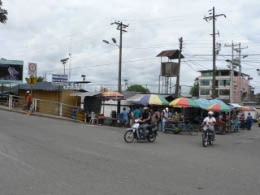
Coca, a God-forsaken frontier town |
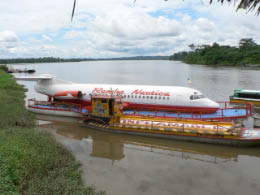
Disco in Coca |
We took a short bus ride to the hot and steamy dock to wait for our boat. Our gang was hungry and anxious to get on the motorized canoe to take us up the Napo River to the Yachana Amazon Lodge.
Bill and I went to the back of the canoe and started our three-hour journey with a gentle breeze to cool us down. Sofy passed out water bottles and our lunches. Lunch hit the spot – chicken sandwich, chips, drinks, banana (which I ignored) and some cookies.
I watched the scenes float by. The jungle came right up to the edge of the river bank. We saw a white egret wading in the shallow waters.
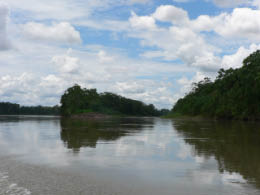
Napo River from our canoe |
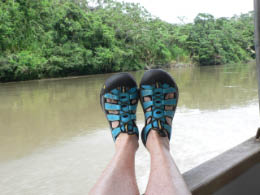
Watching the scenes float by |
Abel stopped the boat at an inlet and did his dolphin-calling whistle hoping to attract a dolphin – but no dolphins today.
Around the bend we saw a couple of big, yellow Caterpillar trucks digging gravel from the river to build the roads to get the oil out. With the taste of oil, this place will be carved up in no time.
I’m crazy about the ride up the river curving through the edge of the jungle trees. Most of my boat mates were snoozing after the lunch while I read my book, “The Beak of the Finch.” I have no clue why I’m riveted by that book – counting, measuring Darwin’s finches and related scientific facts and studies normally doesn’t capture my imagination, but I’ve always liked biology.
At last, the long boat docked at our lodge. We climbed up the steps and made our way through beautiful gardens on the way to the open air lobby framed by a perfect view of the Napo River. We were greeted by the smiling staff distributing warm, moistened washcloths and serving welcome drinks along with snacks – fried banana with cheese. These people will do anything with a banana.
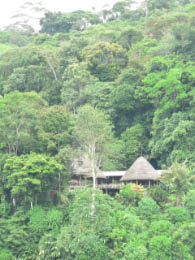
Yachana Lodge |
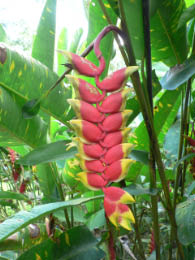
Yachana Lodge |
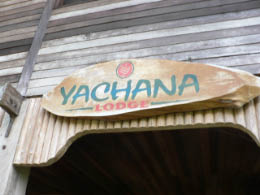
Yachana Lodge |
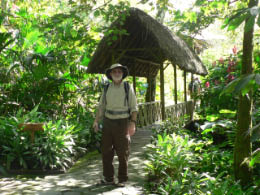
Yachana Lodge |
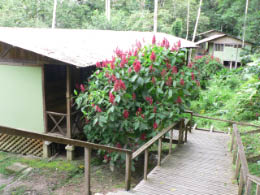
Yachana Lodge |
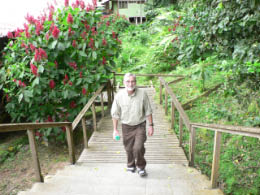
Yachana Lodge |
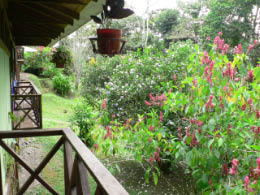
View from our balcony |
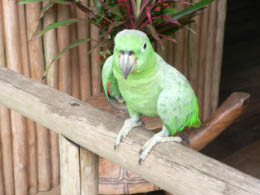
Yachana parrot |
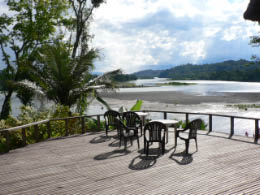
Yachana deck overlooking the Napo River |
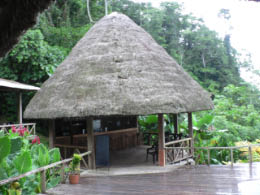
Bar at Yachana |
Abel fitted us with our jungle boots – black rubber slickers. Poor Sharon’s feet were too wide to be fitted. We got our room assignments – #6 for us. The lodge is rustic and the accommodations are nice – great little spot. It’s called the Yachana Lodge (meaning “a place for learning”). The lodge oversees a large plot of land covering forests and agricultural land.
At 4:30, Bill and I shared a large Pilsener (pale lager local beer) at the bar. Frances and Bonnie (from Hawaii) joined us. It was nice to get to know them. Bonnie and Fran are neighbors in Hawaii and good friends. They met through their husbands who were Shriners. (Fran’s husband passed away about 10 years ago. She still misses him.) We learned all about the work Bonnie and Fran do for disabled children who need orthopedic surgery. Fran and Bonnie help get the kids and their families (from all over the world) to Hawaii to get free corrective surgery. It’s a beautiful program.
The group met at 5:45 for our first jungle walk. Abel led the way. We hadn’t gone very far when he spotted a pigmy marmoset monkey. It looked like a rat clinging to a branch. The marmoset has claws instead of finger nails and hangs onto latex trees eating the sap. It bites into the bark and then licks the dripping latex.
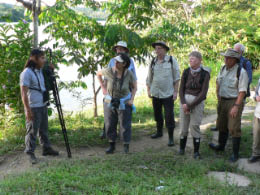
Our group in the Amazon |
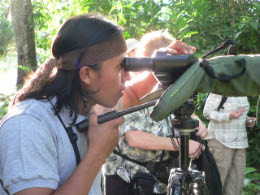
Abel, our Amazon guide |
On the way to the neighboring village of Mondana, we met Douglas McMeekin with a group. Originally from Kentucky, failed at business, he came to work in the oil industry here. He’s well known around here. His foundation owns the lodge and has set up a clinic and a school to foster long-term development for this region in the Ecuadorian Amazon. We would see Douglas a lot around here working the crowds.
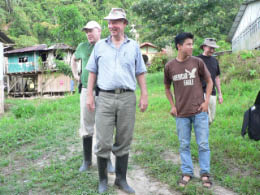
Douglas McMeekin, owner of Yahcana |
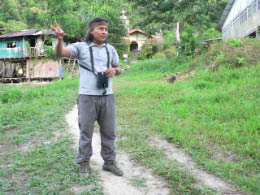
Abel |
The village has about 60 people (10 families with about 120 acres each for their farms) and thanks to Doug’s foundation, it also has a clinic, a school, and a church. Many of the villagers come down to the river to work in various jobs with the oil companies.
The church is important to the village and to several villages nearby. It’s now required that people be married and the babies be baptized in the church. The traveling priest shows up a couple of times a month to preach a little and perform some of the required ceremonies.
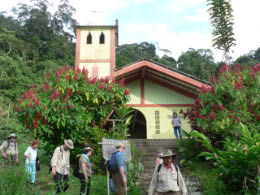
Church in the village of Mondana |
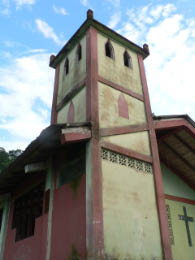
Church |
After our walk, we went back to the lodge’s open lobby area for beer. We watched the resident parrot, who is bilingual, and a bit of a pest and really knows how to work the crowds. Eugene (farmer from Iowa) bonded with the parrot. I took photos of the parrot and the magnificent sunset.
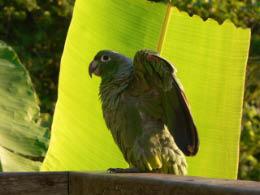
Pet parrot at Yahcana Lodge |
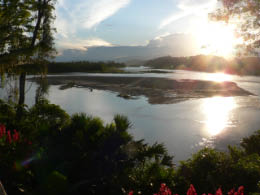
Sunset from Yachana Deck |
| Hot and sweaty, I was able to fit in a cold shower before dinner. There was a large insect, from the bee family, that wanted to share my shower – but the place was not big enough for the both of us. I tried to kill it, but found that task too great a challenge. Things are tough in the Amazon. Because of my giant bee mission in the shower, I missed the free popcorn and Sofy’s talk. DARN, but felt very refreshed for dinner.
Dinner was good. It was a full day – my head is exploding from all the sights and sounds and facts. Need some rest – Shaman Day tomorrow. |
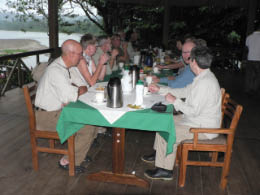
Dinner at Yachana Lodge |
Some random things I learned today from Sofy:
- Ecuador was a much larger country until Peru took a big bite out of it after a war in 1941.
-
Ecuador won the land back in 1995 during a 3 month war. (Sofy was a junior in high school then and politically active.) However, their squirrely president at that time gave the chunk of land back to Peru to keep the peace. Ecuadorians are still pissed.
- Their current vice president, Lenín Moreno Garcés, is disabled – made a paraplegic by a gunshot to the back in a 1998 robbery attempt. He is doing wonders for the disabled people in the country.
- Their President, Mr. Correa, is very involved in several projects – one of which is building roads throughout the country. Once, when he was returning from a speaking engagement at 3 in the afternoon, he saw no building activity – only trucks and tractors parked alongside the road. The next morning he warned the contractor, “If you don’t build the roads, we’ll get somebody who will.” The construction now goes from early morning to late evening. Correa is making huge changes in the country at the same time he is criticized for being too powerful.
- U.S. had a run in with Ecuador just last month. President Correa sent the American ambassador, Heather Hodges, back to the U.S. because of the comments she made in a diplomatic cable released by WikiLeaks. She referred to high-level police corruption in Ecuador and possible knowledge of it by Mr. Correa. In return, the U.S. sent the Ecuadorian ambassador back home as well. Hope they’ve patched it up by now.
Friday, April 22, 2011—A Day with a Shaman
Beautiful weather in the Amazon – no rain.
Abel’s “wake up knock” at the door came at 6:30 with breakfast at 7. We had fruit, toast, and eggs. Everyone, except for me, had the specialty – eggs on a bed of fried bananas. I was fine with my “hold the bananas” eggs.
We took a ten minute ride in a canoe to the Shaman’s house. We’re getting better about boarding and loading onto a boat. In some boats, you must go to the back of the boat over folded down seats and then tip them up as the rows fill in.
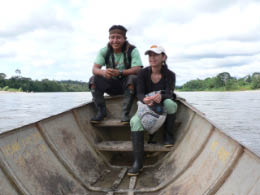
Abel and Sofy |
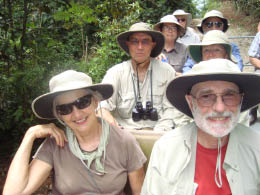
Bill and Nancy heading for Shaman |
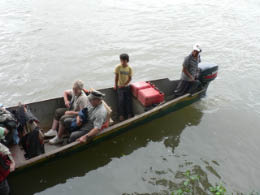
Canoe |
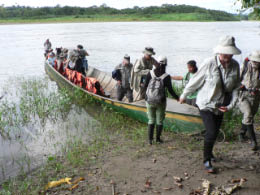
Unloading at Shaman's house |
We disembarked from the boat and took a short walk to the Shaman’s house. We met the Shaman, Domingo, and his lovely and talented wife, Mercedes. We looked around the homestead, admiring all the incredible plants. Abel squeezed the juice from a berry to paint our faces. He was very intent on getting it just right.
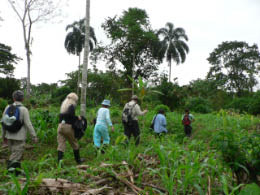
We're off to see the Shaman |
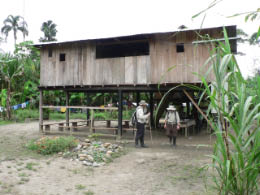
The Shaman's house |
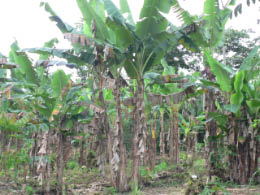
Shaman's garden |
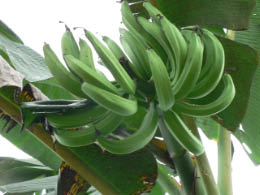
Shaman's bananas |
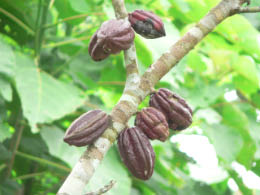
Some kind of fruit |
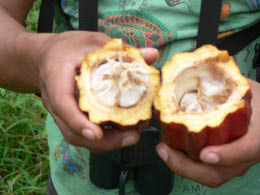
White coca |
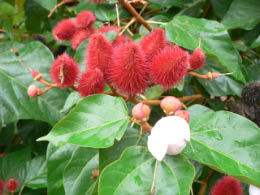
Fruit used for face painting |
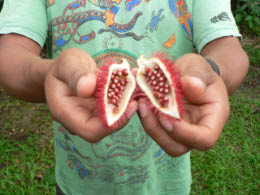
Able holding fruit |
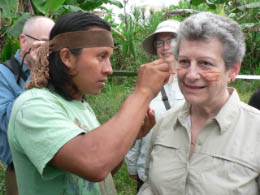
Lisa getting painted |
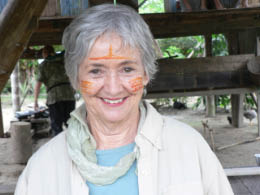
Nancy with face painted |
Mercedes, the Shaman’s wife, showed us how to harvest yuca (also called Cassava or manioc) with a machete. Although she was small and thin, she had strong, graceful, efficient hands. She let us all have a whack at it. It wasn’t as easy as she made it look. We loaded our harvest into a basket made by her husband. In these parts, only the men do the basket weaving. Susan carried (or at least tried to carry) the basket using a strap around her forehead. After a few steps, Mercedes took over. She made that look easy, too.
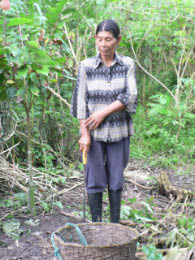
Mercedes |
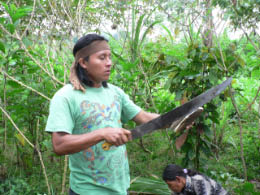
Abel with machete |
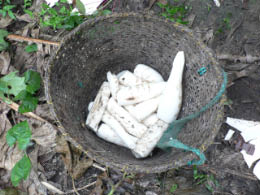
A basket of yuca |
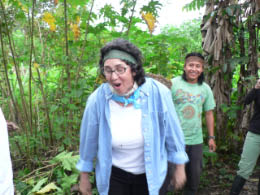
Susan trying to carry yuca |
We brought the yucas to the kitchen area where Mercedes did a cooking demo. With such style, she made a hearts of palm dish with some lime and a little salt, and served it on a banana leaf. The crowd went nuts for it.
Next, Abel showed us some large grubs (AKA as “jungle bacon”) that he found just this morning. He demonstrated how to eat one live, biting off the head quickly so that it doesn’t sting the inside of your mouth. As we groaned, Abel enjoyed the succulent morsel. Mercedes took the rest of the grubs and put them on skewers to roast them over the fire. Most people had a taste of the finished product – but if I’m reluctant about eating a banana, you can imagine how I feel about eating grubs.
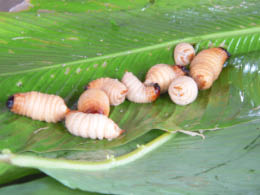
Delicious grubs (jungle bacon) |
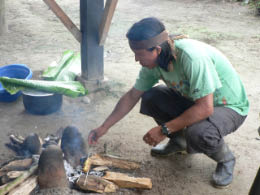
Abel cooking the grubs |
Finally, Mercedes showed us how to cook fresh Tilapia wrapped in a special leaf served with yuca over the open fire. Now that was good! Later she cooked some yuca and mashed some more to be fermented and served as an alcoholic drink.
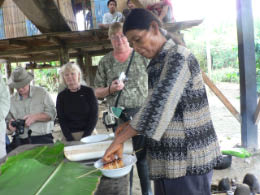
Mercedes preparing lunch |
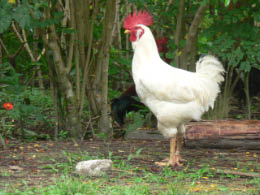
Shaman's rooster |
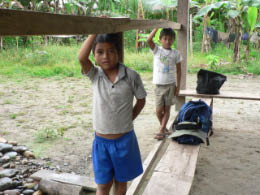
Kids hanging out at the Shaman's house |
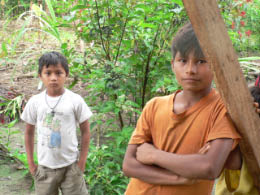
More kids |
Next was Shaman time. Abel first told us about his first healing experience by a Shaman. When he was a kid, he was dying from a curse put on him – a curse intended for his grandfather. Abel comes from a long line of Shamans. His grandfather (now deceased) was a powerful Shaman as is his father. Abel is destined to become a Shaman someday. He definitely has the “magic” – and the animal magnetism. Abel says that being a Shaman is risky business. There are a lot of fakes – and a lot of jealous people that will kill you or put a curse on you.
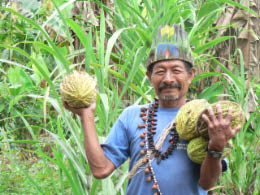
Domingo, the Shaman |
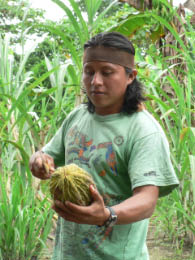
Abel cutting cocao |
Abel grew up in the jungle with 6 brothers and 4 sisters. He was a hunter and very handy with the blow gun. Then he went to work for an oil company. His job was to tell the villagers all the good stuff the oil company would do for them and their villages. Assuming there ever was a “goodness” policy, the oil company changed its philosophy quickly. Within 3 months of his oil PR job, Abel called it quits. On his own, he revisited the villages and told them the truth. He’s quite a guy.
Domingo conducted a Shaman cleansing for us. We went in groups of three. We sat quietly while he whistled and dusted us with his brush made of magical herbs. From time to time he would take puffs from a special cigarette to blow on us. The rhythm, the soft brushing of the leaves, and even the smell of smoke were all very relaxing. In return for his “healing” treatment, I gave him a jar of peanut butter. Last time I offered a jar of peanut butter to the Amazonians, back in ’98, they were thrilled. Domingo and Mercedes didn’t even know what it was. Sofy took Mercedes upstairs, opened the jar to show her what to do with it.
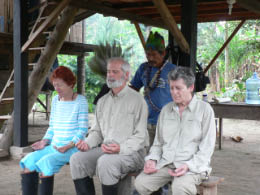
Fran, Steve and Lisa get healed |
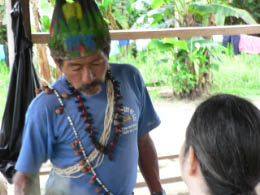
Shaman Domingo |
After the cleansing ceremony, we tried our hand at a little blow gunning and spear throwing. I was terrible at both activities. Most did pretty good. Our 90-year old Fran was a champ. Bill hit the bull’s eye.
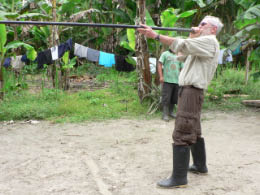
Bill's bull's eye shot |
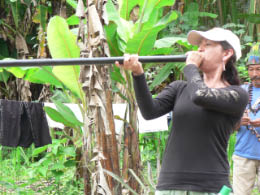
Fierce Sofy withblow gun |

Nancy trying her spear-throwing skills |
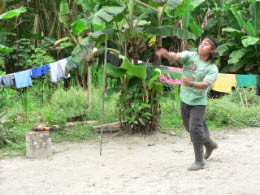
Abel throwing spear |
After a fun morning with Domingo and Mercedes, it was time to go back to the lodge for lunch. Lunch was good – steamed fish wrapped in a leaf with fried yuca. Everyone went for the fried banana for dessert. Sofy ordered fresh pineapple for me – now that’s a great tour leader. We sat by Susan and Frank – a sweetheart couple from Ukiah in Mendocino County, California. She’s lively and makes everything so nice for others.
We had about 40 minutes to catch our breath before the next outing – visiting the high school in the nearby village. We took a short boat ride and walked up a hill to the school. The kids study agriculture, animal husbandry and small business.
| The students come from all around and stay in the dorms and go to the school. Only 15 out of 100 kids get accepted. These are the best and brightest in the region. For our program, about 6 or 7 students introduced themselves in English. They were very shy. Then kids did some strange athletic and acrobatic moves to entertain us. Afterwards, they sold silk screen printed t-shirts, jewelry and other handicraft items that they made. I gave them my bag of harmonicas, recorders and pencils that I had brought from home. Like my gift of peanut butter earlier in the morning, the kids didn’t exactly go nuts on these little items. It’s tough to know what to buy. |
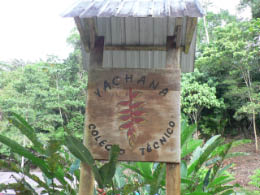
Yachana Colelgio Technico |
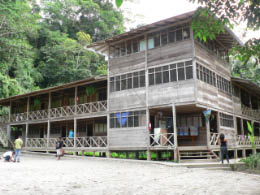
Yachana High School |
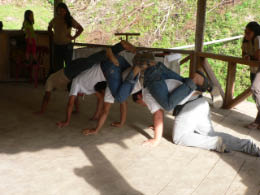
Kids at school "performing" |
We walked from the school over the hill and back to the lodge (forget about the boat). Abel pointed out the fat pigs the students were raising and the African sheep. We saw a big bird sleeping in a tree that looked like an owl – maybe he was one.
The Easter holidays have come to the village. The disco was going full blast with some romantic music that Sofy liked. We didn’t see the disco or where the music was coming from – I just listened to the tones in the village. We saw some cute kids with big smiles – always so happy to greet us.
Abel pointed out a single Balsa tree and told how it’s changing the local economy and becoming a real cash cow. It takes only 3–4 years for a Balsa tree to mature and then it brings in the price of $15,000. Everyone wants to get into the Balsa tree action. It costs $80 for a pound of seed to get going – a lot of money. (The Balsa seed guy is doing very well for sure.)
Abel showed us a snail farm. It was fenced in to keep the animals out (and I suppose the snails in). Like everything else in the jungle, these snails were giants and will make some mighty good escargot eating. They go for about $8 a pound at the market. |
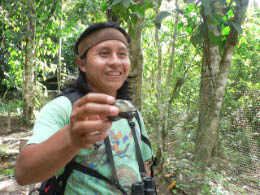
Abel with a snail |
We walked back to our rooms and then had dinner at the lodge at 7:30 -- excellent spaghetti dish. Sharon and Eugene sat next to us. It was fascinating learning all about being farmers in Iowa -- not an easy occupation. They have some dairy cows and grow corn for ethanol. They are lovely people -- salt of the earth types, survivors, and quite a remarkable couple.
After dinner, the students from the high school came down to dance at the lodge. The girls, with their gorgeous, perfect little brown bodies, wore their traditional costumes which happened to be very sexy -- coconut shells for their bra and lots of beads swaying for their skirt. I sensed that many a weary old male traveler felt like a young boy again. Bill danced with a young thing who had so much energy. He was trying to do the moves to keep up while smiling a lot.
| We were too exhausted to do the night walk with Sofy and Abel. Frank, Susan, Steve and Claudia went out – sorry we missed it. They saw a poison green tree frog with googly eyes and a tail-less scorpion, among other things. Susan bought a brand new Canon camera for the trip. She took some wonderful photos and sent one of the tree frogs.
We went back to our room to recover and get ready for a 6 o’clock wake up knock and another jam-packed day. |

Poison green tree frog |
It actually got cold in the jungle tonight. I found another blanket just to keep warm.
NOTE: There’s a group of Mormon kids at the lodge here to do some good deeds. The personality of the lodge changes as each new group comes and goes.
Saturday, April 23, 2011—Jungle Walk
We had another big breakfast – real bacon (not “jungle bacon”) and eggs. We sat across from Susan and had a few laughs. We were all attacked by some pesky little stingless bees. A lot of them found their way into our orange juice. I tilted my glass sideways to make the little bugger swim upstream, just for my own amusement.
At 7:30 we boarded the canoe for a ten-minute ride up the Napo to the local market.
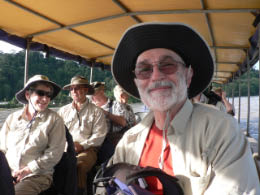
Canoe to local market |
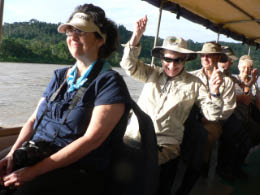
Susan, with Lisa behind |
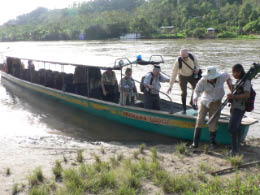
Going to the market |
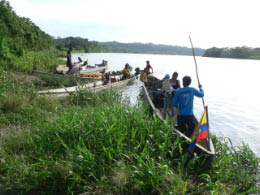
Local canoes |
There was lots of activity in the marketplace. We saw a lot of kids, teens, and families, all hanging out at the market. Farmers came from miles to sell their produce – bananas, eggs, potatoes, meat, etc. There were also middlemen out to sell the usual Walmart stuff – clothes, backpacks, toiletries and the best seller of them all was the beer distributor. We spotted a group of young adults dragging their empties to market in exchange for refills. We strolled through the market trying to look like we belonged – fat chance.
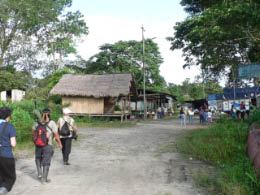
Local market |
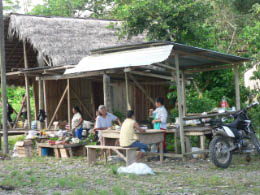
Local market |
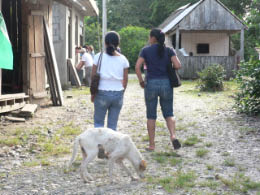
Shoppers at the market |
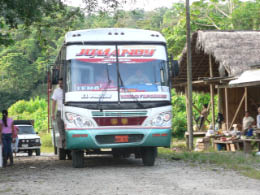
Bus bringing shoppers to market |
Just beyond the market, we boarded a rickety, cool double decker bus for a wild ride to our jungle trail. We sat on the top level and sucked it all in. We drove up and down a windy road with views of the jungle, scattered farms and rolling hills. You could just feel the Amazon open up its soul to you – what a grand experience. We stopped at several places to identify the birds – little ones, big ones. I only recall the roadside hawk – I thought Abel said “Roadside Cock” – oh well. (Steve, from our group, could list them all – He’s on a mission to document the birds.)
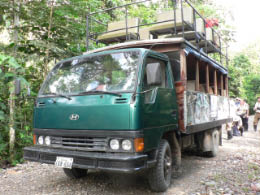
Bus to the jungle |
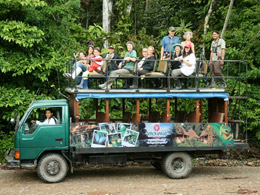
Double decker bus |
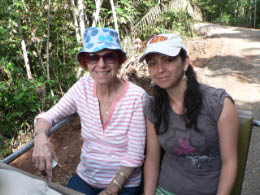
Fran and Sofy |
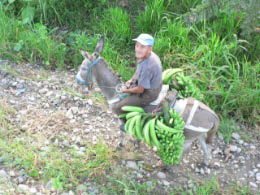
Donkey man |
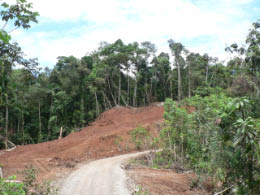
Jungle road |
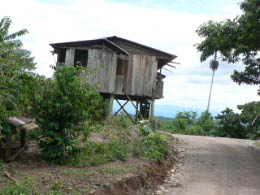
Hut in the jungle |
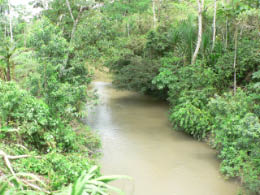
Jungle stream |
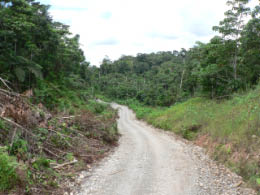
Jungle |
The bus let us off at the start of a very muddy two-hour hike. It was here that we saw Abel at his grandest. He loves life and loves the jungle and knows how to survive. He’s the kind of guy we don’t bump into very often back in the states. He gave us an insider’s look at the Jungle.
He stopped to add a few knife cuts to a tree and said the bark on this particular tree needs to be cut in order to grow – otherwise, the tree dies.
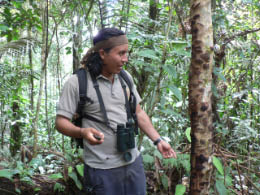
Abel, ready to attack |
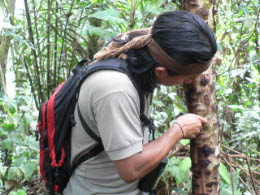
Abel cutting |
Next he grabbed a large palm leaf and wove it into a handy basket. With another palm leaf, he wove a shield so that the animals couldn’t find him, if he was out on a hunt. With a few adjustments, he turned that shield into a mattress. He showed us how the hostile tribes use a woven sign. Others passing through their territory must know the secret of how to un-weave the sign without breaking the leaves. With the code, they are “friend” and safe.
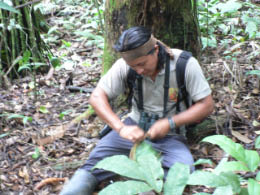
Abel making a basket |
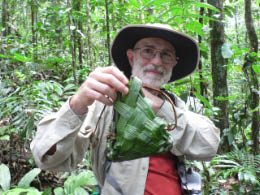
Looks like a man purse to me |
With a flick of the hand, Abel grabbed a tiny blue frog from the jungle floor. The frog was of the poisonous variety which are used for poison darts. The poor little frog was putty in Abel’s hands. We thought the frog was dead. He was very much alive, and seemed to be happy hanging with Abel.
We also saw bullet ants. They are huge and can be really mean.
Abel showed us the plant used for snake bites. Nobody in his family has had a snake bite – but his father helps a lot of folks survive snake bites with his magic and knowledge of medicinal plants. |
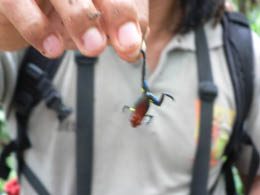
Abel holding the poisonous frog |
Abel showed us the Coca tree (for cocaine) used to make tea to counteract altitude sickness (and I suppose used for cocaine as well).
Abel also showed us the Quinine tree (used to combat malaria). It was here in the jungle that the people figured out that this tree cures malaria.
Gail and I tasted a vine at Abel’s request. It numbed our lips. It’s used on the blow gun darts to stun animals so they can be easily killed. You don’t want to mess up your meat with poison darts.
We saw a walking tree that moves 7 centimeters a year.

Nancy biting vine |

Nancy - numb lips |
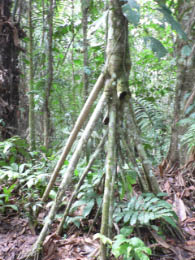
Walking tree |
Abel showed us a “phone tree” – a tree that carries sound very well. When you’re lost in the jungle, you find a phone tree and bang on it a few times so others will know where to locate you. Abel has actually used the “phone tree” once – handy to have in an area without cell phone coverage.
A very friendly tree in the jungle is the Fortress tree. It looks like a big fichus tree. Mini fortresses are sectioned off by the tree’s tall, wide roots. One of these fortresses makes a great place to spend the night in the dark jungle. Just weave a roof and a mattress and curl up in between the root sections and nobody can find you. And if you’re worried that the animals will sniff you out, just go to a termites’ nest and disturb them. They’ll come pouring out on your hands and arms. Abel demonstrated this technique and rubbed the termite bodies deeply into his arms. They had a surprisingly pleasant smell.
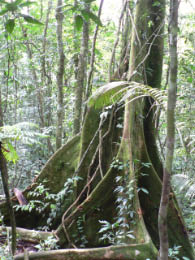
Fortress Tree |
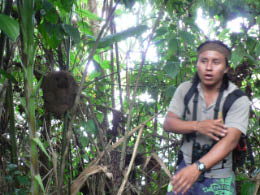
Abel with termite nest |
Abel showed us a patch of beautiful blue mushrooms. We were not to touch them. They were hallucinogenic – reserved for Shaman use only. It was a most fascinating tour of the jungle. We didn’t mind the slippery muddy trails. Sharon and Eugene retrieved some walking sticks for a few of the group.
We boarded our rickety bus for the return home. I enjoyed the view from high up. We almost had a couple of head on collisions. One truck scrapped the side of our bus – but it’s a “no worries” kind of place around here. From the bus, we boarded the boat and went back to the lodge.
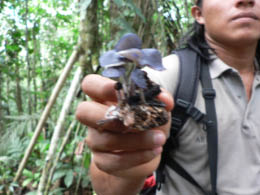
Blue mushrooms |
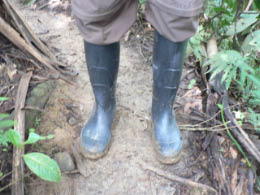
Jungle boots |
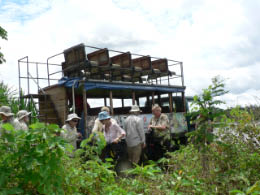
Getting back on the bus |
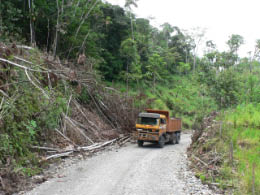
On-coming traffic |
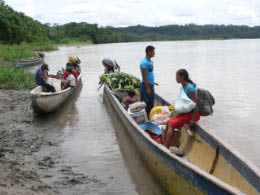
Going home from market |
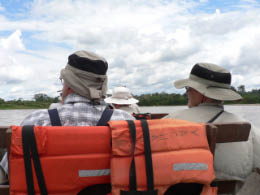
Back on the river |
Bill and I had just enough time to check out the butterfly house before lunch. The butterflies seemed very happy in their own house with ready meals. I saw a couple beauties. On the way out, I’m afraid we let one out. He’s probably missing his mommy now.
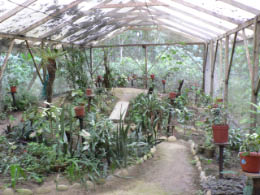
Yachana Butterfly House |
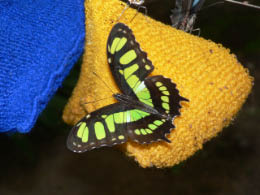
Yachana Butterfly House |
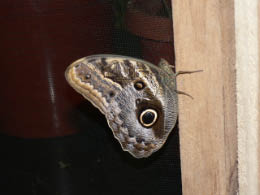
Yachana Butterfly House |
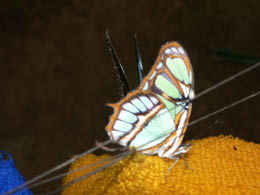
Yachana Butterfly House |
We had a delicious lunch – chili relleno – except it was made with yuca, cheese and corn and served with hearts of palm-ceviche style and pinto beans.
| At 2:45 we boarded the boat to go in search of the Stinky Turkey, a large prehistoric bird. We found a couple of large birds flapping around and feeding on the fresh green shoots growing in the swampy lake. They are vegans only. They have two stomachs – one for bacteria and one for fermentation. They taste so bad nobody, except the caiman, will eat them. The young Stinky Turkeys have claws attached to their wings to escape the caiman trying to get to them from their nests down by the river. They are a very weird bird. |

Stinky turkeys |
I dreaded our next river adventure – floating down the Rio Napo in inner tubes. I faced my fears and had the time of my life. We took the boat way upstream from the lodge and got off. Abel tied about 8 or 9 inner tubes together. We got a beer, found our spot in the tubes and piled in. Abel and Alberto (the student intern at the lodge) gave us a sendoff. We screamed and laughed and drank and giggled for about 30 minutes. We asked Alberto to sing us a song as he guided us along. He sang “Happy Birthday” because he knew it. From time to time, he would swim back to the boat to get us more beer. We overshot the landing and had more laughs and screams. We all came back giddy from the experience and to think I was afraid of the big scary river.

Our river adventure begins |

Fun on the Napo River |
We went back to our room to clean up and get ready for dinner. We bought Zion a hammock from the gift shop. She’s been asking for a hammock.
Douglas McMeekin, Head of Yachana Foundation, sat with us to solicit funds. We told him we are building a school in Cambodia. More people seemed interested in our story. Poor guy – I think it frustrated him.
After dinner, we hung out with Frank, Susan, Steve and Claudia looking at Susan’s photos – she has some really nice ones.
We saw a lot today and are sad to be leaving. We had to get our money, settle up our bills at the bar and then go back to the room to pack.
Much to our horror, we found a gigantic cock roach on our night stand in the room eating Bill’s Pepto Bismol tablet. You can’t kill those suckers. Later, I assume the same roach had the gall to climb up on my bed looking for food, I assume.
We packed up. I’m sad to think it’s our last night in the Amazon. I listened to all the sounds – the cricket’s, the birds, the frogs and Lord knows what all. Just as I was getting sentimental, a bug dropped from somewhere and ended up on my thigh. Maybe it’s time to be moving on.
NOTE: I learned that our Abel, our #1 Adventure Man, has a 7 month old son, who is probably destined to be a Shaman.
Easter Sunday, April 24, 2011 – Amazon back to Quito
We had our last breakfast at the lodge in the Amazon. A fleet of annoying, persistent stingless bees interrupted a perfectly lovely breakfast. When the people at the next table were served, the bees left us and migrated to them.
We said Good-bye to our beautiful jungle lodge and loaded on the boat to go back to Coca. I was able to enjoy my book, “The Beak of the Finches.” The trip was much faster going back to Coca because we were going down river.
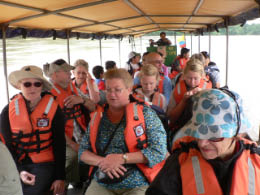
Heading back to Coca |
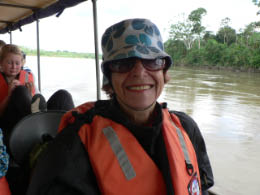
Fran |
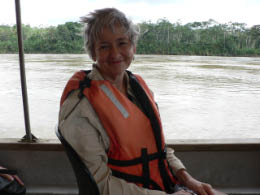
Nancy |
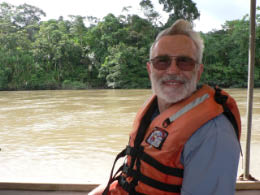
Bill |
We arrived in Coca and saw the huge bridge being built over the Napo. While we waited at the dock for the bags to be unloaded, a pesky monkey named Pepe was causing nothing but trouble. He was trying to grab the food from the tables while concessioners were shoeing him away. We all loved the commotion.
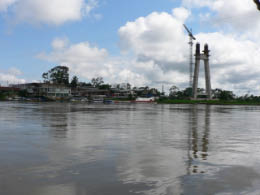
Napo River with new brige under construction |
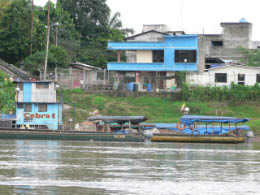
Napo River |
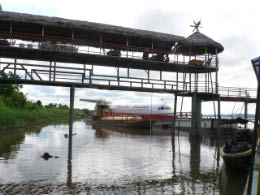
Napo River |
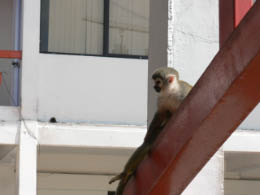
Pepe the monkey |
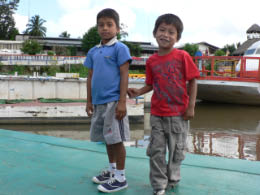
Kids by the river |
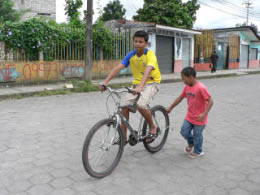
Kids from Coca |
| We had a little time before our departure back to Quito. Sofy took us on a walk into the main part of Coca to see their typical market. It was Easter Sunday and a lot of friends and families were out having fun. We roamed through the streets in amazement. We saw vendors grilling “jungle bacon” (AKA grubs) while people were lining up to buy a juicy tidbit. We stopped in a local handicraft shop down by the river. I took some photos and bought some beaded earrings. |

Nancy at the market |
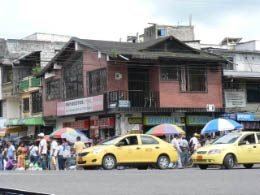
Coca market |
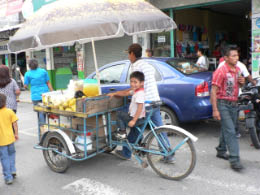
Coca market |
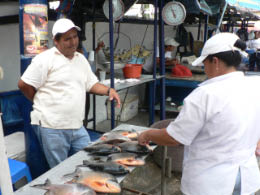
Coca market |
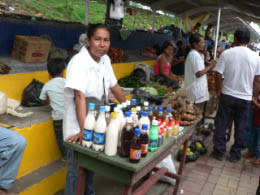
Coca market |
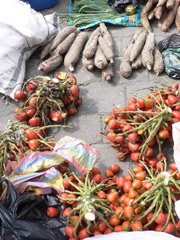
Coca market |
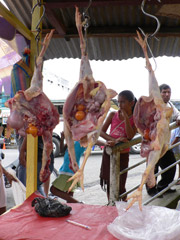
Coca market |
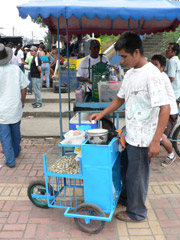
Coca market |
From the market, Sofy walked us around the corner to our taxis. Instead of taxis, there was a line of ten bicycles with attached “cabs” waiting for us. Each couple packed themselves and their bags into the “cab” attached to the bike. I picked the taxi with the leanest, meanest looking driver and he turned out to be a real champion. Despite a few setbacks and delays due to stop lights and traffic, he beat all the others on the way to the VIP office. In fact, he beat them by a large margin and wasn’t even breathing hard when we gave him his tip. What a winner!
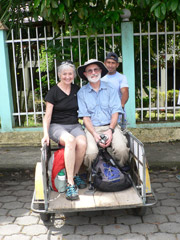
Bill and Nancy |
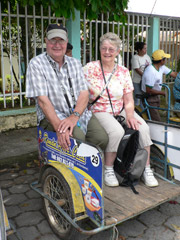
Gene and Sharon |

Nancy chose a winner |
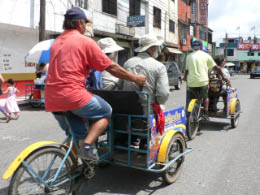
Off to the airport |
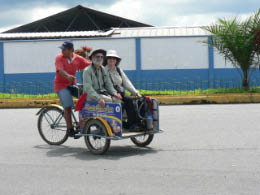
Steve and Claudia |
After a short fight, we landed back in Quito and boarded the bus, with the same driver we had a few days before. We made a stop at a local produce market. It was huge -- the fruits and veggies looked so perfect stacked up high. Several of the gang ordered a lunch at the stand. Bill and I split some French fries to stave off the hunger, but they were way too greasy. We could feel our arteries snapping shut with each bite.
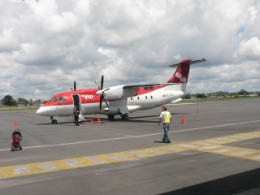
Back to Quito |

Sofy |
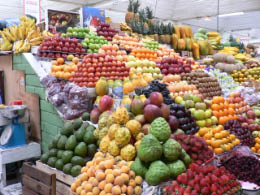
Quito Market |
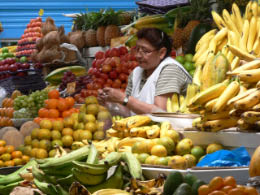
Quito Market |
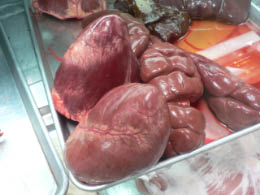
Quito Market |
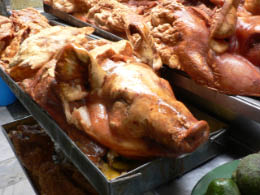
Quito Market |
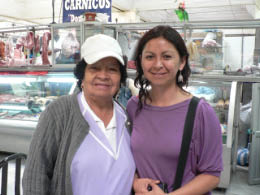
Sofy and her friend |
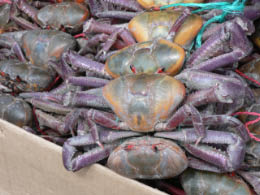
Quito Market |
We got back on the bus to go the hotel. It took longer to get back because on Sundays, Quito closes its main street for bicycling. Is that not civilized or what? We drove by a big park loaded with people enjoying Easter Sunday.
It was just starting to rain when we arrived at our hotel – the same Hotel Reina Isabel – except a different room. This one was nicer, with a grand view of the city.
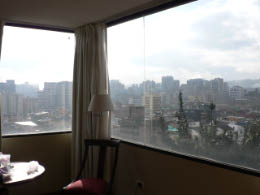
View from hotel |
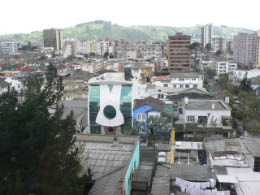
View from hotel |
We joined Ken and Gail and went to a sandwich shop (Italian) just around the corner from the hotel. We enjoyed our lunch and getting to know them better. They’re a really nice couple from Scottsdale – just retired from long social services careers in Wisconsin. They bike and hike a lot and now have the time to travel. They are a real asset to the group.
We came back to the room to sort through our dirty clothes and send our laundry out so we’d have clean clothes for the Galapagos adventure tomorrow. Sofy’s laundry connection only charges $4 a pound – well worth it.
On our free afternoon, Sofy took a group of us interested to the National Archeology Museum (Museo Nacional de Banco Central del Ecuador). I’ve never seen such treasures. (I couldn’t document the displays because no photos allowed.) Sofy once worked at the museum. She said all the items are real – no reproductions in this museum.
We visited the main floor, the Archaeological Gallery with items dating back to 11,000 B.C., from the time of the pre-Columbian and pre Inca people. Everything is displayed chronologically. Sofy, who knows the place well, gave us an overview of the sections and pointed out her favorite pieces. Here’s just some of the things that lingered in my brain.
The Ecuadorians crossed over the Siberian Peninsular (near where Sarah Palin lives) and made their way southward to South America. Over the centuries, they set up commerce and had an expansive network of marketplaces and trade centers along the western coast of South America. They used shells as currency. We saw some of the actual “money” shells.
The residents valued pointy heads and went to great lengths to construct and wear head presses to shape the skull of their babies. (Beauty must suffer.)
A region in Ecuador was the very first to have clay pots. Cases and cases of pots were on display. Some were practical with long legs attached for putting over fires. Some had amazing designs dating back to 2000 B.C. Many of the designs incorporated the hawk (representing air), the jaguar (representing fire), the snake (representing earth) and the caiman (representing water). These were powerful symbols in the civilization – especially the jaguar.
There were jugs shaped like birds and animals. If you blew into the jug, it would produce the sound of the animal it represented. For example, a bird jug would sound like the bird whistle.
I especially enjoyed the pots and sculptures that showed the human faces and bodies. They were simple designs with plump, happy faces. Sofy said they looked like her – and they did. We all got a kick out of the fertility statues and figures in Kama Sutra poses – guess we’re not too far removed from Junior High. Sex and procreation were very big and widely celebrated.
Some of the displays looked very Chinese and some looked very Egyptian. They were so similar it made you feel there had to be a direct connection. One case displayed an ET looking figure and another case held a figure with three eyes. Of course we wondered if this place had contact with aliens from outer space.
After what we saw in the ancient artwork and designs, believe me, this was no primitive civilization. The pre-Columbian and pre Inca civilizations were developing nicely. Then, after a while, the Mayans came to conquer and merge, followed by the Incas. In man’s glorious tradition of stepping over dead bodies to get ahead, Spain came next to rub out the Mayans and Incas. During those war years, in the 1500’s, the people no longer had the time or resources to make such intricate, elaborate designs on their pots. Just like in the U.S., we no longer have the time or resources for music or art programs in the schools. – Damn Wars!
We viewed case after case of fascinating treasures. Most were retrieved from graves. The body was placed in a large jar in the fetal position with valuable worldly possession scattered about. These worldly possessions were the bulk of the museum’s collection.
We came to came to a case holding the Cañari mummy who was discovered in a cave. She was a 15 year old girl who lived sometime between 500 and 1400 AD. She was mummified due to conditions in the jar or cave, and now preserved for all to see. We chatted on as if she were just another item, another pot. We commented on the few long dark strands of hair left, the green discoloration on her cheek bones (from wearing ornamentation), her woven dress with the simple design, her belt and other details left over from her worldly being. I felt sad for her – She once was somebody’s daughter or wife or mother and now she’s just a thing in a glass display case. I wish the museum had created a more private resting place so that we could quietly observe her and then pay our respected to this young girl from an ancient civilization.
The real jewel of the museum was “The Golden Court,” a special exhibit of gold treasures. Sofy said this exhibit had just been restored and was only opened about 2 months ago. Because many Indigenous groups worshipped the sun and used gold, they created amazing ornaments and objects -- necklaces, ear rings, nose rings (very big nose rings), masks, chest decorations, and figurines. We saw cases of splendid pure gold adornments, many of which symbolized the sun. I’ve heard about such gold, but never have seen so much in one location. Is there any wonder why the Spanish came to look for gold in South America – and step over a lot of dead bodies?
Sofy told us the last Inca King was kidnapped by the Spaniards. The Spanish told the Incas that if they gave a ransom—a room full of gold— their beloved king would be released. The room was filled with gold, but the king was killed anyway. The story got around and the Incas learned not to trust the Spaniards. To protect what was left of their gold, the Incas stashed all the gold they could get their hands on in a hiding place just as the Spanish were overtaking the city of Quito. Rumor has it that a large storehouse of gold is hidden somewhere in Quito. One day some farmer will probably uncover the golden treasure out in his field – seems to always happen that way.
I loved the museum and was surprised to notice that only one other couple was in the building – what a rare treasure. Sofy made the visit very special.
On the way back to the hotel, Bill and I stopped at the Handicraft market to buy some souvenirs. It was painful for Bill to take -- the crowds, the heavy rain and endless stalls of trinkets. To add to his misery, his laryngitis seems to be taking over. He’s been fighting it since the flight over.
We managed to buy some stuff and dashed back to the hotel after a downpour. Powerful “Apocalypse Now” thunder echoed throughout the town and shook us to our very core. Mother Nature is letting us know who’s boss. (I found it exhilarating.)
We were all surprised to learn that no beer is sold on Sundays after 12:30. It’s a government policy to keep hung over drunks from coming to work on Monday in a stupor. What kind of place is this?
We met at 6:30 for Sofy’s debriefing. Maureen told us she was robbed today while out visiting some churches on her own. They got her camera with all her photos. As if that weren’t bad enough, she learned that a killer tornado touched down in St. Louis just 10 minutes from her house. Not a good day for Maureen.
After the debriefing, about 8 of us went with Sofy to her favorite little restaurant just a few blocks away. We ordered a little chicken soup for Bill (which turned out to be a whole chicken) and a traditional Ecuadorian dinner. Bill and I are a couple of sad sacks -- he can’t talk (laryngitis has a grip on him) and I can’t hear, especially in a loud restaurant. However, we did enjoy the food and the Indigenous looking guy dressed in a spiffy suit playing jazz-like music on a strange looking harp. I was intrigued enough to give him a tip.
We returned to the hotel lobby to claim our laundry and then went back to the room to repack and re-group for the Galapagos adventure.
| 










